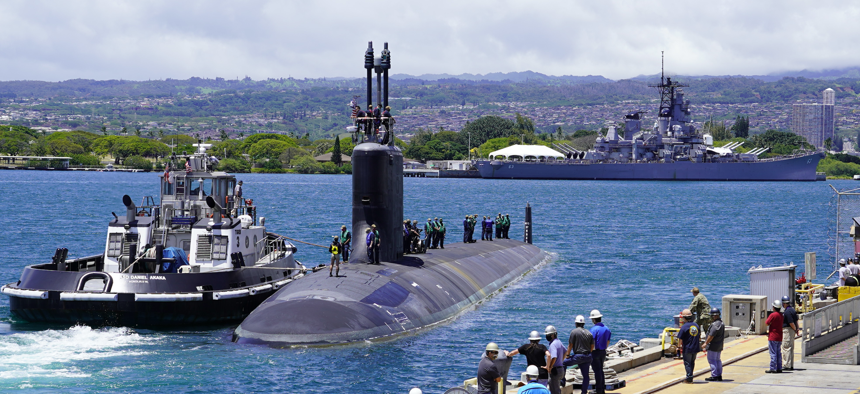
USS Missouri (SSN 780), a Virginia-class fast-attack submarine, departs Pearl Harbor Naval Shipyard and Intermediate Maintenance Facility on May 10, 2020. U.S. Navy / Justice Vannatta
Esper Plans Fewer Large Carriers, More Subs in a Navy of 500 Ships or More
He says it’s affordable, but key details remain unknown.
Nine months after wresting control of naval force planning, Defense Secretary Mark Esper rolled out a new 25-year roadmap that reiterates the U.S. Navy’s goal of about 355 manned ships and adds roughly half as many unmanned vessels on top.
Esper’s plan seeks “eight to 11” nuclear carriers — today’s fleet has 11 — and possibly more of the conventionally powered smaller carriers called amphibious assault ships.
He also wants an attack submarine force of 70 to 80 boats, up from today’s roughly 55.
“If we do nothing else, the Navy must reach production of three new Virginia-class subs per year,” the defense secretary said. That’s up from the current annual production of about two. But it also seems slightly askew from the Pentagon’s long-stated position that nothing is more important than replacing the bombers, missiles, and submarines that form the nuclear triad.
Esper spoke Tuesday at a virtual event hosted by the Center for Strategic and Budgetary Assessments think tank in Washington. He described an outline of his plan, dubbed “Battle Force 2045,” but as of press time had apparently distributed no documents with more details.
The planning began in January, when Esper became dissatisfied with the Navy’s own force-structure plan, itself in the works for more than a year. The defense secretary ordered up several new reviews — all “cost-constrained,” he said Tuesday — by the Navy, one by the Pentagon’s Cost Assessment and Program Evaluation office, and the Hudson Institute think tank. Their results fed the Future Naval Force Study, overseen by Deputy Secretary of Defense David Norquist, which has now produced Battle Force 2045.
Esper hinted at the outcome in a Sept. 16 speech at RAND, in which he called for a fleet of over 350 ships, but Tuesday’s event added a few more details and his first official announcement that he would seek about half again as many unmanned surface and subsurface vessels.
Among other things, Battle Force 2045 envisions 60 to 70 smaller manned surface ships that can relieve larger ones of “day-to-day” missions. It foresees 70 to 90 combat support vessels. And, he added, the future Navy will include unmanned aircraft “of every type,” including refueling, electronic warfare, and airborne early warning.
All this, Esper said, can be executed at a price tag that Congress can swallow.
“To start, we have charted a critical path to reaching 355 ships that works within real-world budget constraints,” he said. “We now have a credible path for reaching 355 ships in an era of fiscal constraints.”
Part of that increased shipbuilding budget, he said, will come from the efficiencies that he ordered the Navy — and other services — to find in January. Part will come, he hopes, from Congressional acquiescence to proposals to allow the Navy to retire older ships and systems and to hang on to shipbuilding funds left unused at the end of a fiscal year.
He did not talk in any detail about how such a large Navy would be maintained by a service that is having trouble keeping up its current fleet, nor where the additional money for more sailors would come from.
The plan is sure to face stiff opposition from the powerful aircraft carrier lobby, while at least one lawmaker who represents a submarine-building state was quick to praise its emphasis on subs.
“If Secretary Esper is serious about boosting production, he could direct his department to support the House-passed authorization and funding levels for a second Virginia-class submarine in 2021 that reverses the Administration’s anemic shipbuilding budget in the House-Senate conference process happening right now,” said a statement from Rep. Joe Courtney, D-Connecticut, who leads the House Armed Services’ panel on Seapower and Projection Forces.
Courtney’s statement underlines that the increase in submarine production is probably the nearest-term aspect of the plan that can be accomplished, though the Navy this year awarded the first major contract for its planned new class of guided-missile frigates.
Esper released the plan just weeks ahead of a presidential election. Regardless of the results, the defense budget is expected to flatten in the coming years — something even more likely as the coronavirus pandemic has further increased U.S. debt.
“We are now at a point where we can — and indeed we must — chart a new path to a future fleet that will maintain our naval superiority long into the future,” Esper said. “Today, cutting edge technologies are fundamentally altering the character of warfare and expanding the geometry of the battlefield in multiple ways,” he said. “In the maritime domain, artificial intelligence, autonomous systems, ubiquitous sensors, and long-range precision weapons will play an increasingly leading role in a future high end fight. Whoever harnesses these technologies first, will have a clear advantage on the high seas for years to come. Getting there ahead of everyone else demands a whole-of-nation effort. ”



